Wastewater-Based Surveillance of SARS-CoV-2 and Modeling of COVID-19 Infection Trends
Abstract
1. Introduction
2. Materials and Methods
2.1. Collection of Wastewater Samples and Viral Detection
2.2. Sources of COVID-19 Surveillance and Respiratory Outpatient Data
2.3. Data Processing and Analysis
2.3.1. Basic Data Collection
2.3.2. Data Preprocessing
2.3.3. Statistical Analysis Methods
3. Results
3.1. Overall Detection of SARS-CoV-2
3.2. Detection of SARS-CoV-2 Viral Load
3.3. COVID-19 Testing Results from Sentinel Hospitals
3.4. Comparison of SARS-CoV-2 Viral Load Trends and Estimated Infection Trends Based on Sentinel Hospital Positivity Rates
3.5. Lag Analysis Between SARS-CoV-2 Viral Load in Wastewater and Infection Cases
3.5.1. Lag Analysis Between Viral Load and Total Estimated Infections
3.5.2. Lag Analysis Between Viral Load and Gender-Specific Infection Cases
3.5.3. Lag Analysis Between Viral Load and Age-Specific Infection Cases
3.6. Wastewater SARS-CoV-2 Viral Load and Lag Associations with Outpatient Visits
3.6.1. Lag Analysis Between Viral Load and Outpatient Visits by Hospital Type
3.6.2. Lag Effect Between Viral Load and Outpatient Visits by Sex
3.6.3. Lag Effect Between Viral Load and Outpatient Visits by Age Group
4. Discussion
5. Conclusions
Author Contributions
Funding
Institutional Review Board Statement
Informed Consent Statement
Data Availability Statement
Acknowledgments
Conflicts of Interest
Abbreviations
| SARS-CoV-2 | Severe acute respiratory syndrome coronavirus 2 |
| COVID-19 | Coronavirus disease 2019 |
| WBE | Wastewater-based epidemiology |
| RT-qPCR | Reverse transcription quantitative polymerase chain reaction |
| N | Nucleocapsid |
| N3 | Lower concentration between N1 and N2 on each sampling day |
| N4 | Higher concentration between N1 and N2 on each sampling day |
References
- COVID-19 Cases|WHO COVID-19 Dashboard. Available online: https://data.who.int/dashboards/covid19/cases (accessed on 14 July 2025).
- Miller, M.B.; Ooi, E.E.; Rhoads, D.D.; Kulldorff, M.; Anderson, D.E.; Lee, H.; Gupta, S.; Mel, K. As Omicron Takes Hold and Other New Variants Arise, COVID-19 Testing Remains the Universally Agreed Tool to Effect Transition from Pandemic to Endemic State. Front. Public Health 2022, 10, 883066. [Google Scholar] [CrossRef]
- Meyerowitz, E.A.; Richterman, A.; Gandhi, R.T.; Sax, P.E. Transmission of SARS-CoV-2: A Review of Viral, Host, and Environmental Factors. Ann. Intern. Med. 2021, 174, 69–79. [Google Scholar] [CrossRef]
- Kellingray, L.; Savva, G.M.; Garcia-Gutierrez, E.; Snell, J.; Romano, S.; Yara, D.A.; Altera, A.; de Oliveira Martins, L.; Hutchins, C.; Baker, D.; et al. Temporal dynamics of SARS-CoV-2 shedding in feces and saliva: A longitudinal study in Norfolk, United Kingdom during the 2021-2022 COVID-19 waves. Microbiol. Spectr. 2025, 13, e0319524. [Google Scholar] [CrossRef]
- Termansen, M.B.; Frische, S. Fecal-oral transmission of SARS-CoV-2: A systematic review of evidence from epidemiological and experimental studies. Am. J. Infect. Control 2023, 51, 1430–1437. [Google Scholar] [CrossRef] [PubMed]
- Torabi, S.; Amirsoleimani, A.; Dehghan Banadaki, M.; Strike, W.D.; Rockward, A.; Noble, A.; Liversedge, M.; Keck, J.W.; Berry, S.M. Stabilization of SARS-CoV-2 RNA in wastewater via rapid RNA extraction. Sci. Total Environ. 2023, 878, 162992. [Google Scholar] [CrossRef] [PubMed]
- Hokajärvi, A.-M.; Rytkönen, A.; Tiwari, A.; Kauppinen, A.; Oikarinen, S.; Lehto, K.-M.; Kankaanpää, A.; Gunnar, T.; Al-Hello, H.; Blomqvist, S.; et al. The detection and stability of the SARS-CoV-2 RNA biomarkers in wastewater influent in Helsinki, Finland. Sci. Total Environ. 2021, 770, 145274. [Google Scholar] [CrossRef] [PubMed]
- Perez-Zabaleta, M.; Berg, C.; Latorre-Margalef, N.; Owusu-Agyeman, I.; Kiyar, A.; Botnen, H.; Schönning, C.; Hugerth, L.W.; Cetecioglu, Z. Wastewater surveillance of SARS-CoV-2 from aircraft to citywide monitoring. Nat. Commun. 2025, 16, 5125. [Google Scholar] [CrossRef]
- Maida, C.M.; Amodio, E.; Mazzucco, W.; La Rosa, G.; Lucentini, L.; Suffredini, E.; Palermo, M.; Andolina, G.; Iaia, F.R.; Merlo, F.; et al. Wastewater-based epidemiology for early warning of SARS-CoV-2 circulation: A pilot study conducted in Sicily, Italy. Int. J. Hyg. Environ. Health 2022, 242, 113948. [Google Scholar] [CrossRef]
- Ng, W.-Y.; Thoe, W.; Yang, R.; Cheung, W.-P.; Chen, C.-K.; To, K.-H.; Pak, K.-M.; Leung, H.-W.; Lai, W.-K.; Wong, T.-K.; et al. The city-wide full-scale interactive application of sewage surveillance programme for assisting real-time COVID-19 pandemic control—A case study in Hong Kong. Sci. Total Environ. 2023, 875, 162661. [Google Scholar] [CrossRef]
- Armas, F.; Chandra, F.; Lee, W.L.; Gu, X.; Chen, H.; Xiao, A.; Leifels, M.; Wuertz, S.; Alm, E.J.; Thompson, J. Contextualizing Wastewater-Based surveillance in the COVID-19 vaccination era. Environ. Int. 2023, 171, 107718. [Google Scholar] [CrossRef]
- Bigouette, J.P.; Henderson, E.; Traoré, M.A.; Wassilak, S.G.F.; Jorba, J.; Mahoney, F.; Bolu, O.; Diop, O.M.; Burns, C.C. Update on Vaccine-Derived Poliovirus Outbreaks-Worldwide, January 2021-December 2022. MMWR Morb. Mortal. Wkly. Rep. 2023, 72, 366–371. [Google Scholar] [CrossRef]
- National Health Commission of the People’s Republic of China. Method for Enrichment and Nucleic acid Detection of SARS-CoV-2 in Sewage. Available online: https://www.nhc.gov.cn/wjw/pgw/202204/1e63b7f24c2346dab4559462b2542549.shtml (accessed on 31 August 2025).
- Brown, J.R.; O’Sullivan, D.M.; Shah, D.; Atkinson, L.; Pereira, R.P.A.; Whale, A.S.; Busby, E.J.; Huggett, J.F.; Harris, K. Comparison of SARS-CoV-2 N gene real-time RT-PCR targets and commercially available mastermixes. J. Virol. Methods 2021, 295, 114215. [Google Scholar] [CrossRef]
- Vogels, C.B.F.; Brito, A.F.; Wyllie, A.L.; Fauver, J.R.; Ott, I.M.; Kalinich, C.C.; Petrone, M.E.; Casanovas-Massana, A.; Catherine Muenker, M.; Moore, A.J.; et al. Analytical sensitivity and efficiency comparisons of SARS-CoV-2 RT-qPCR primer-probe sets. Nat. Microbiol. 2020, 5, 1299–1305. [Google Scholar] [CrossRef]
- Bertels, X.; Hanoteaux, S.; Janssens, R.; Maloux, H.; Verhaegen, B.; Delputte, P.; Boogaerts, T.; van Nuijs, A.L.N.; Brogna, D.; Linard, C.; et al. Time series modelling for wastewater-based epidemiology of COVID-19: A nationwide study in 40 wastewater treatment plants of Belgium, February 2021 to June 2022. Sci. Total Environ. 2023, 899, 165603. [Google Scholar] [CrossRef] [PubMed]
- Schoen, M.E.; Wolfe, M.K.; Li, L.; Duong, D.; White, B.J.; Hughes, B.; Boehm, A.B. SARS-CoV-2 RNA Wastewater Settled Solids Surveillance Frequency and Impact on Predicted COVID-19 Incidence Using a Distributed Lag Model. ACS ES T Water 2022, 2, 2167–2174. [Google Scholar] [CrossRef] [PubMed]
- McManus, O.; Christiansen, L.E.; Nauta, M.; Krogsgaard, L.W.; Bahrenscheer, N.S.; von Kappelgaard, L.; Christiansen, T.; Hansen, M.; Hansen, N.C.; Kähler, J.; et al. Predicting COVID-19 Incidence Using Wastewater Surveillance Data, Denmark, October 2021-June 2022. Emerg. Infect. Dis. 2023, 29, 1589–1597. [Google Scholar] [CrossRef]
- Armstrong, B.G.; Gasparrini, A.; Tobias, A. Conditional Poisson models: A flexible alternative to conditional logistic case cross-over analysis. BMC Med. Res. Methodol. 2014, 14, 122. [Google Scholar] [CrossRef] [PubMed]
- Carracedo-Martínez, E.; Taracido, M.; Tobias, A.; Saez, M.; Figueiras, A. Case-crossover analysis of air pollution health effects: A systematic review of methodology and application. Environ. Health Perspect. 2010, 118, 1173–1182. [Google Scholar] [CrossRef]
- Figueiras, A.; Cadarso-Suárez, C. Application of nonparametric models for calculating odds ratios and their confidence intervals for continuous exposures. Am. J. Epidemiol. 2001, 154, 264–275. [Google Scholar] [CrossRef]
- Glatman-Freedman, A.; Gur-Arie, L.; Sefty, H.; Kaufman, Z.; Bromberg, M.; Dichtiar, R.; Rosenberg, A.; Pando, R.; Nemet, I.; Kliker, L.; et al. The impact of SARS-CoV-2 on respiratory syndromic and sentinel surveillance in Israel, 2020: A new perspective on established systems. Euro Surveill. 2022, 27, 2100457. [Google Scholar] [CrossRef]
- Flores-Alvarado, S.; Olivares, M.F.; Vergara, N.; García, C.; Canals, M.; Cuadrado, C. Nowcasting methods to improve the performance of respiratory sentinel surveillance: Lessons from the COVID-19 pandemic. Sci. Rep. 2024, 14, 12582. [Google Scholar] [CrossRef]
- Toh, K.B.; Runge, M.; Richardson, R.A.; Hladish, T.J.; Gerardin, J. Design of effective outpatient sentinel surveillance for COVID-19 decision-making: A modeling study. BMC Infect. Dis. 2023, 23, 287. [Google Scholar] [CrossRef]
- Mori, H.; Yoshida, H.; Mori, H.; Shiraki, T.; Kawakami, K. Stealth Omicron: A Novel SARS-CoV-2 Variant That Is Insensitive to RT-qPCR Using the N1 and N2 Primer-Probes. Cureus 2023, 15, e36373. [Google Scholar] [CrossRef]
- Mannarà, G.; Martinelli, M.; Giubbi, C.; Rizza, M.; Giordano, E.; Perdoni, F.; Bruno, E.; Morella, A.; Azzellino, A.; Turolla, A.; et al. Wastewater Surveillance for SARS-CoV-2 in Northern Italy: An Evaluation of Three Different Gene Targets. Microorganisms 2025, 13, 236. [Google Scholar] [CrossRef] [PubMed]
- Grube, A.M.; Coleman, C.K.; LaMontagne, C.D.; Miller, M.E.; Kothegal, N.P.; Holcomb, D.A.; Blackwood, A.D.; Clerkin, T.J.; Serre, M.L.; Engel, L.S.; et al. Detection of SARS-CoV-2 RNA in wastewater and comparison to COVID-19 cases in two sewersheds, North Carolina, USA. Sci. Total Environ. 2023, 858, 159996. [Google Scholar] [CrossRef] [PubMed]
- Rimoldi, S.G.; Stefani, F.; Gigantiello, A.; Polesello, S.; Comandatore, F.; Mileto, D.; Maresca, M.; Longobardi, C.; Mancon, A.; Romeri, F.; et al. Presence and infectivity of SARS-CoV-2 virus in wastewaters and rivers. Sci. Total Environ. 2020, 744, 140911. [Google Scholar] [CrossRef] [PubMed]
- Bertels, X.; Demeyer, P.; Van den Bogaert, S.; Boogaerts, T.; van Nuijs, A.L.N.; Delputte, P.; Lahousse, L. Factors influencing SARS-CoV-2 RNA concentrations in wastewater up to the sampling stage: A systematic review. Sci. Total Environ. 2022, 820, 153290. [Google Scholar] [CrossRef]
- Hata, A.; Katayama, H.; Kojima, K.; Sano, S.; Kasuga, I.; Kitajima, M.; Furumai, H. Effects of rainfall events on the occurrence and detection efficiency of viruses in river water impacted by combined sewer overflows. Sci. Total Environ. 2014, 468–469, 757–763. [Google Scholar] [CrossRef]
- Ciota, A.T.; Keyel, A.C. The Role of Temperature in Transmission of Zoonotic Arboviruses. Viruses 2019, 11, 1013. [Google Scholar] [CrossRef]
- Hong, P.-Y.; Rachmadi, A.T.; Mantilla-Calderon, D.; Alkahtani, M.; Bashawri, Y.M.; Al Qarni, H.; O’Reilly, K.M.; Zhou, J. Estimating the minimum number of SARS-CoV-2 infected cases needed to detect viral RNA in wastewater: To what extent of the outbreak can surveillance of wastewater tell us? Environ. Res. 2021, 195, 110748. [Google Scholar] [CrossRef]
- Nemudryi, A.; Nemudraia, A.; Wiegand, T.; Surya, K.; Buyukyoruk, M.; Cicha, C.; Vanderwood, K.K.; Wilkinson, R.; Wiedenheft, B. Temporal Detection and Phylogenetic Assessment of SARS-CoV-2 in Municipal Wastewater. Cell Rep. Med. 2020, 1, 100098. [Google Scholar] [CrossRef]
- Petala, M.; Kostoglou, M.; Karapantsios, T.; Dovas, C.I.; Lytras, T.; Paraskevis, D.; Roilides, E.; Koutsolioutsou-Benaki, A.; Panagiotakopoulos, G.; Sypsa, V.; et al. Relating SARS-CoV-2 shedding rate in wastewater to daily positive tests data: A consistent model based approach. Sci. Total Environ. 2022, 807, 150838. [Google Scholar] [CrossRef]
- Shim, E.; Choi, W.; Song, Y. Clinical Time Delay Distributions of COVID-19 in 2020-2022 in the Republic of Korea: Inferences from a Nationwide Database Analysis. J. Clin. Med. 2022, 11, 3269. [Google Scholar] [CrossRef]
- D’Aoust, P.M.; Graber, T.E.; Mercier, E.; Montpetit, D.; Alexandrov, I.; Neault, N.; Baig, A.T.; Mayne, J.; Zhang, X.; Alain, T.; et al. Catching a resurgence: Increase in SARS-CoV-2 viral RNA identified in wastewater 48 h before COVID-19 clinical tests and 96 h before hospitalizations. Sci. Total Environ. 2021, 770, 145319. [Google Scholar] [CrossRef]
- Xiao, A.; Wu, F.; Bushman, M.; Zhang, J.; Imakaev, M.; Chai, P.R.; Duvallet, C.; Endo, N.; Erickson, T.B.; Armas, F.; et al. Metrics to relate COVID-19 wastewater data to clinical testing dynamics. Water Res. 2022, 212, 118070. [Google Scholar] [CrossRef]
- Haraguchi, M.; Klaassen, F.; Cohen, T.; Salomon, J.A.; Menzies, N.A. Statistical Relationship Between Wastewater Data and Case Notifications for COVID-19 Surveillance in the United States From 2020 to 2023: Bayesian Hierarchical Modeling Approach. JMIR Public Health Surveill. 2025, 11, e68213. [Google Scholar] [CrossRef]
- Meadows, T.; Coats, E.R.; Narum, S.; Top, E.M.; Ridenhour, B.J.; Stalder, T. Epidemiological model can forecast COVID-19 outbreaks from wastewater-based surveillance in rural communities. Water Res. 2025, 268, 122671. [Google Scholar] [CrossRef]
- Peccia, J.; Zulli, A.; Brackney, D.E.; Grubaugh, N.D.; Kaplan, E.H.; Casanovas-Massana, A.; Ko, A.I.; Malik, A.A.; Wang, D.; Wang, M.; et al. Measurement of SARS-CoV-2 RNA in wastewater tracks community infection dynamics. Nat. Biotechnol. 2020, 38, 1164–1167. [Google Scholar] [CrossRef]
- Ansari, N.; Kabir, F.; Khan, W.; Khalid, F.; Malik, A.A.; Warren, J.L.; Mehmood, U.; Kazi, A.M.; Yildirim, I.; Tanner, W.; et al. Environmental surveillance for COVID-19 using SARS-CoV-2 RNA concentration in wastewater—A study in District East, Karachi, Pakistan. Lancet Reg. Health Southeast. Asia 2024, 20, 100299. [Google Scholar] [CrossRef]
- Arbel, Y.; Fialkoff, C.; Kerner, A.; Kerner, M. Do population density, socio-economic ranking and Gini Index of cities influence infection rates from coronavirus? Israel as a case study. Ann. Reg. Sci. 2022, 68, 181–206. [Google Scholar] [CrossRef]
- Choi, K.H.; Denice, P. Socioeconomic Variation in the Relationship Between Neighbourhoods’ Built Environments and the Spread of COVID-19 in Toronto, Canada. Can. Stud. Popul. 2022, 49, 149–181. [Google Scholar] [CrossRef]
- Ling, L.; Qian, X.; Guo, S.; Ukkusuri, S.V. Spatiotemporal impacts of human activities and socio-demographics during the COVID-19 outbreak in the US. BMC Public Health 2022, 22, 1466. [Google Scholar] [CrossRef]
- Qin, Z.; Ng, S.; Wu, W.; Zhang, S. What Chinese Women Seek in Mental Health Apps: Insights from Analyzing Xiaohongshu User Posts during the COVID-19 Pandemic. Healthcare 2024, 12, 1297. [Google Scholar] [CrossRef]
- Alothman, S.A.; Alghannam, A.F.; Almasud, A.A.; Altalhi, A.S.; Al-Hazzaa, H.M. Lifestyle behaviors trend and their relationship with fear level of COVID-19: Cross-sectional study in Saudi Arabia. PLoS ONE 2021, 16, e0257904. [Google Scholar] [CrossRef]
- Rattay, P.; Michalski, N.; Domanska, O.M.; Kaltwasser, A.; De Bock, F.; Wieler, L.H.; Jordan, S. Differences in risk perception, knowledge and protective behaviour regarding COVID-19 by education level among women and men in Germany. Results from the COVID-19 Snapshot Monitoring (COSMO) study. PLoS ONE 2021, 16, e0251694. [Google Scholar] [CrossRef]
- Zhang, S.; Yang, Z.; Li, Z.-N.; Chen, Z.-L.; Yue, S.-J.; Fu, R.-J.; Xu, D.-Q.; Zhang, S.; Tang, Y.-P. Are Older People Really More Susceptible to SARS-CoV-2? Aging Dis. 2022, 13, 1336–1347. [Google Scholar] [CrossRef]
- Puhach, O.; Meyer, B.; Eckerle, I. SARS-CoV-2 viral load and shedding kinetics. Nat. Rev. Microbiol. 2023, 21, 147–161. [Google Scholar] [CrossRef]
- Davis, A.L.; Sunderji, A.; Marneni, S.R.; Seiler, M.; Hall, J.E.; Cotanda, C.P.; Klein, E.J.; Brown, J.C.; Gelernter, R.; Griffiths, M.A.; et al. Caregiver-reported delay in presentation to pediatric emergency departments for fear of contracting COVID-19: A multi-national cross-sectional study. CJEM 2021, 23, 778–786. [Google Scholar] [CrossRef]
- Gaborieau, L.; Delestrain, C.; Bensaid, P.; Vizeneux, A.; Blanc, P.; Garraffo, A.; Georget, E.; Chalvon, A.; Garrec, N.; Laoudi, Y.; et al. Epidemiology and Clinical Presentation of Children Hospitalized with SARS-CoV-2 Infection in Suburbs of Paris. J. Clin. Med. 2020, 9, 2227. [Google Scholar] [CrossRef]
- Delestrain, C.; Danis, K.; Hau, I.; Behillil, S.; Billard, M.-N.; Krajten, L.; Cohen, R.; Bont, L.; Epaud, R. Impact of COVID-19 social distancing on viral infection in France: A delayed outbreak of RSV. Pediatr. Pulmonol. 2021, 56, 3669–3673. [Google Scholar] [CrossRef]
- Recher, M.; Fall, S.F.K.; Lockhart-Bouron, M.; Lacan, L.; Theis, D.; Leteurtre, S.; Bruandet, A. Impact of the COVID-19 lockdown period on hospital admissions for paediatric accidents: A French nationwide study. Eur. J. Pediatr. 2024, 184, 63. [Google Scholar] [CrossRef] [PubMed]
- Ahmed, W.; Angel, N.; Edson, J.; Bibby, K.; Bivins, A.; O’Brien, J.W.; Choi, P.M.; Kitajima, M.; Simpson, S.L.; Li, J.; et al. First confirmed detection of SARS-CoV-2 in untreated wastewater in Australia: A proof of concept for the wastewater surveillance of COVID-19 in the community. Sci. Total Environ. 2020, 728, 138764. [Google Scholar] [CrossRef] [PubMed]
- Sasidharan, S.; Sarkar, N.; Saudagar, P. Discovery of compounds inhibiting SARS-CoV-2 multi-targets. J. Biomol. Struct. Dyn. 2023, 41, 2602–2617. [Google Scholar] [CrossRef]
- McGowan, J.; Borucki, M.; Omairi, H.; Varghese, M.; Vellani, S.; Chakravarty, S.; Fan, S.; Chattopadhyay, S.; Siddiquee, M.; Thissen, J.B.; et al. SARS-CoV-2 Monitoring in Wastewater Reveals Novel Variants and Biomarkers of Infection. Viruses 2022, 14, 2032. [Google Scholar] [CrossRef]
- Harris-Lovett, S.; Nelson, K.L.; Beamer, P.; Bischel, H.N.; Bivins, A.; Bruder, A.; Butler, C.; Camenisch, T.D.; De Long, S.K.; Karthikeyan, S.; et al. Wastewater Surveillance for SARS-CoV-2 on College Campuses: Initial Efforts, Lessons Learned, and Research Needs. Int. J. Environ. Res. Public Health 2021, 18, 4455. [Google Scholar] [CrossRef]
- Tlhagale, M.; Liphadzi, S.; Bhagwan, J.; Naidoo, V.; Jonas, K.; van Vuuren, L.; Medema, G.; Andrews, L.; Béen, F.; Ferreira, M.L.; et al. Establishment of local wastewater-based surveillance programmes in response to the spread and infection of COVID-19-case studies from South Africa, the Netherlands, Turkey and England. J. Water Health 2022, 20, 287–299. [Google Scholar] [CrossRef]
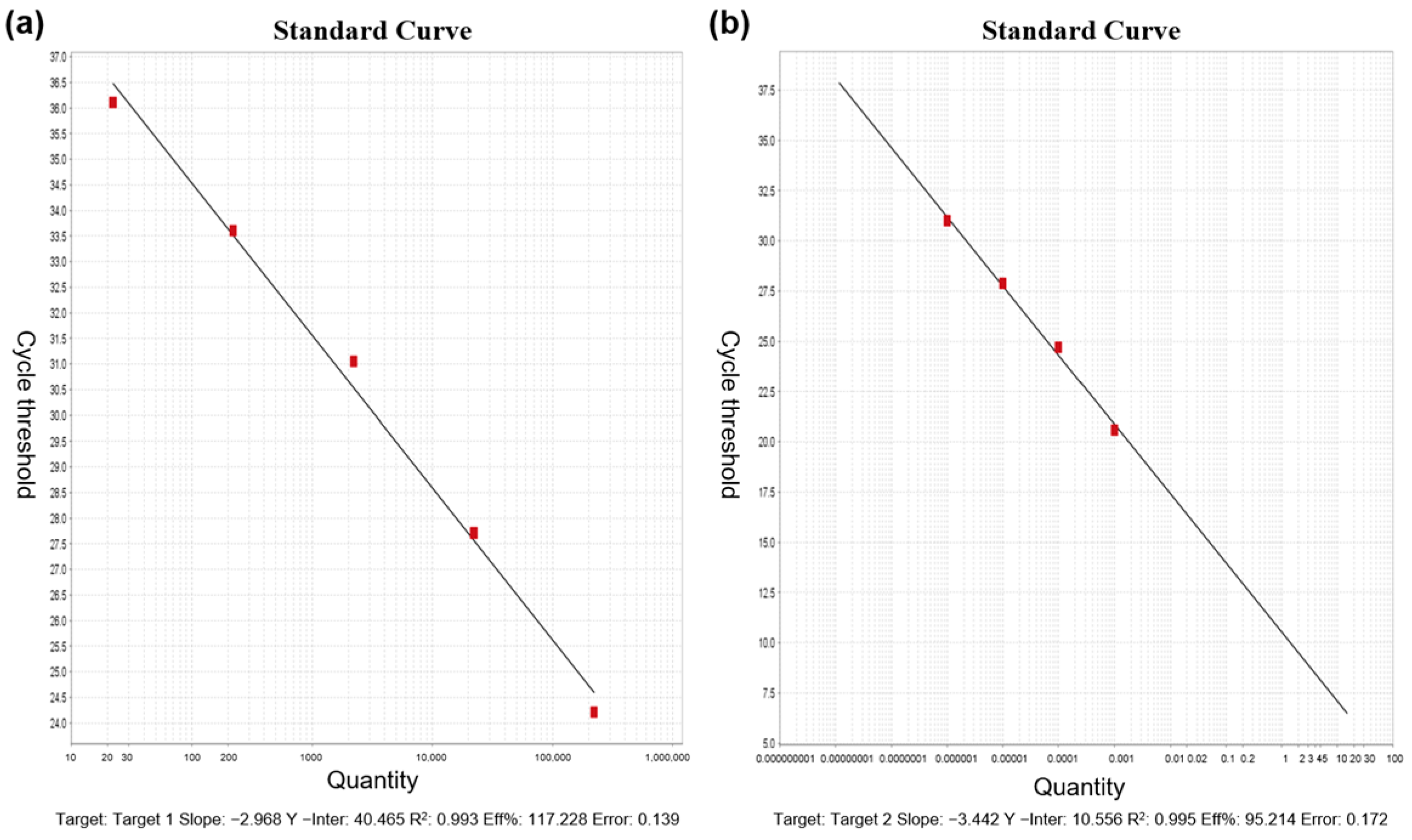
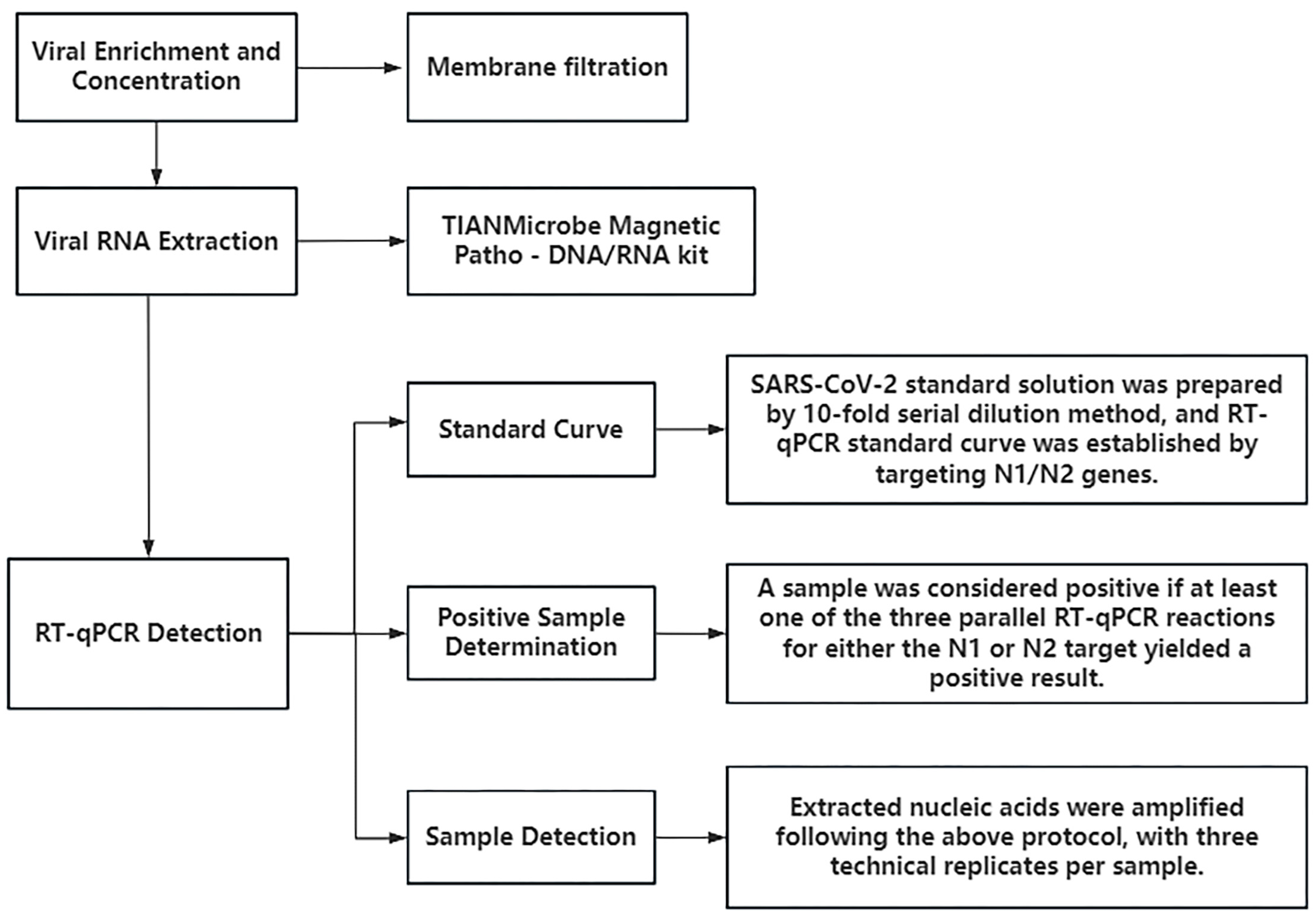
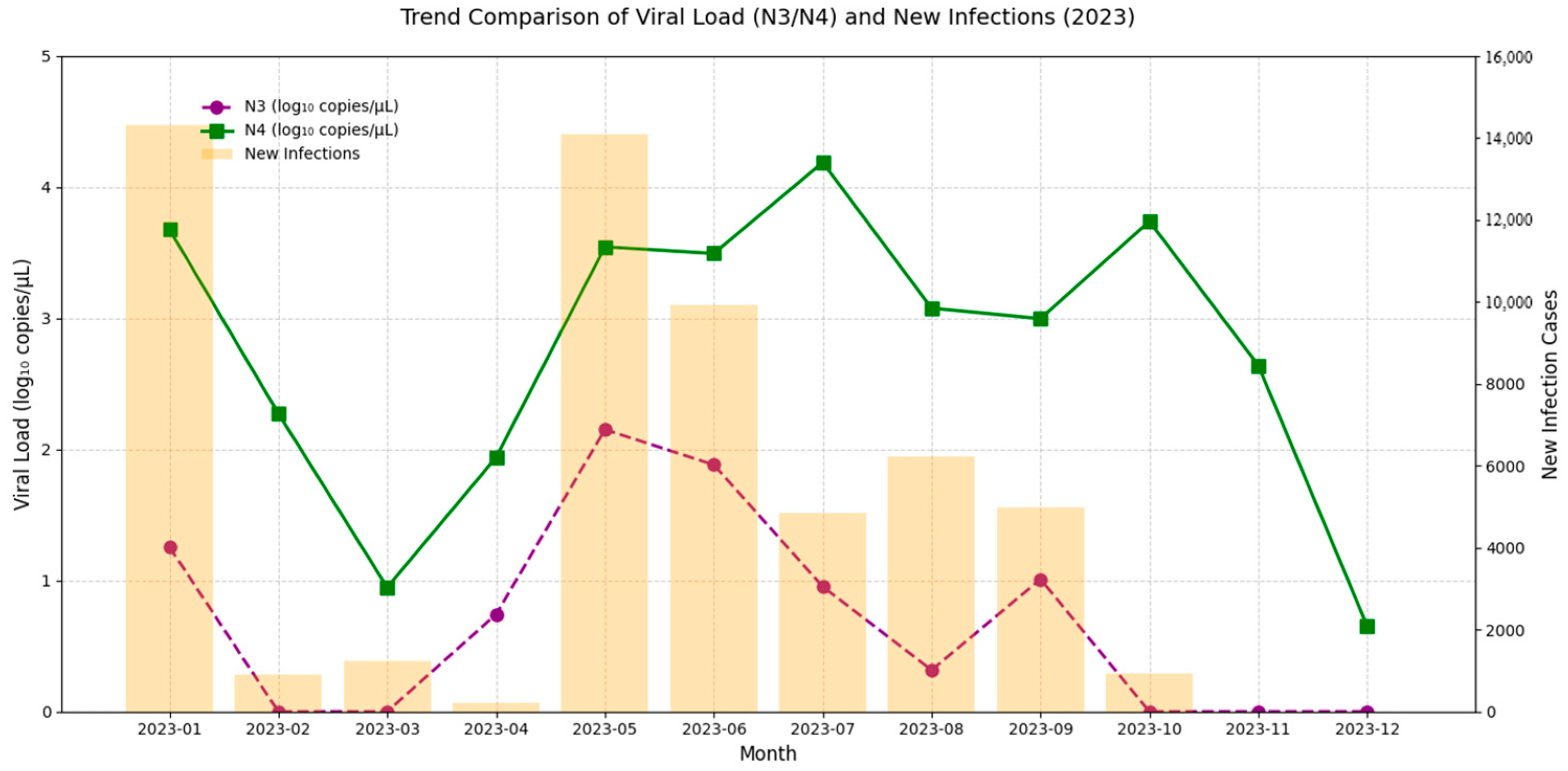
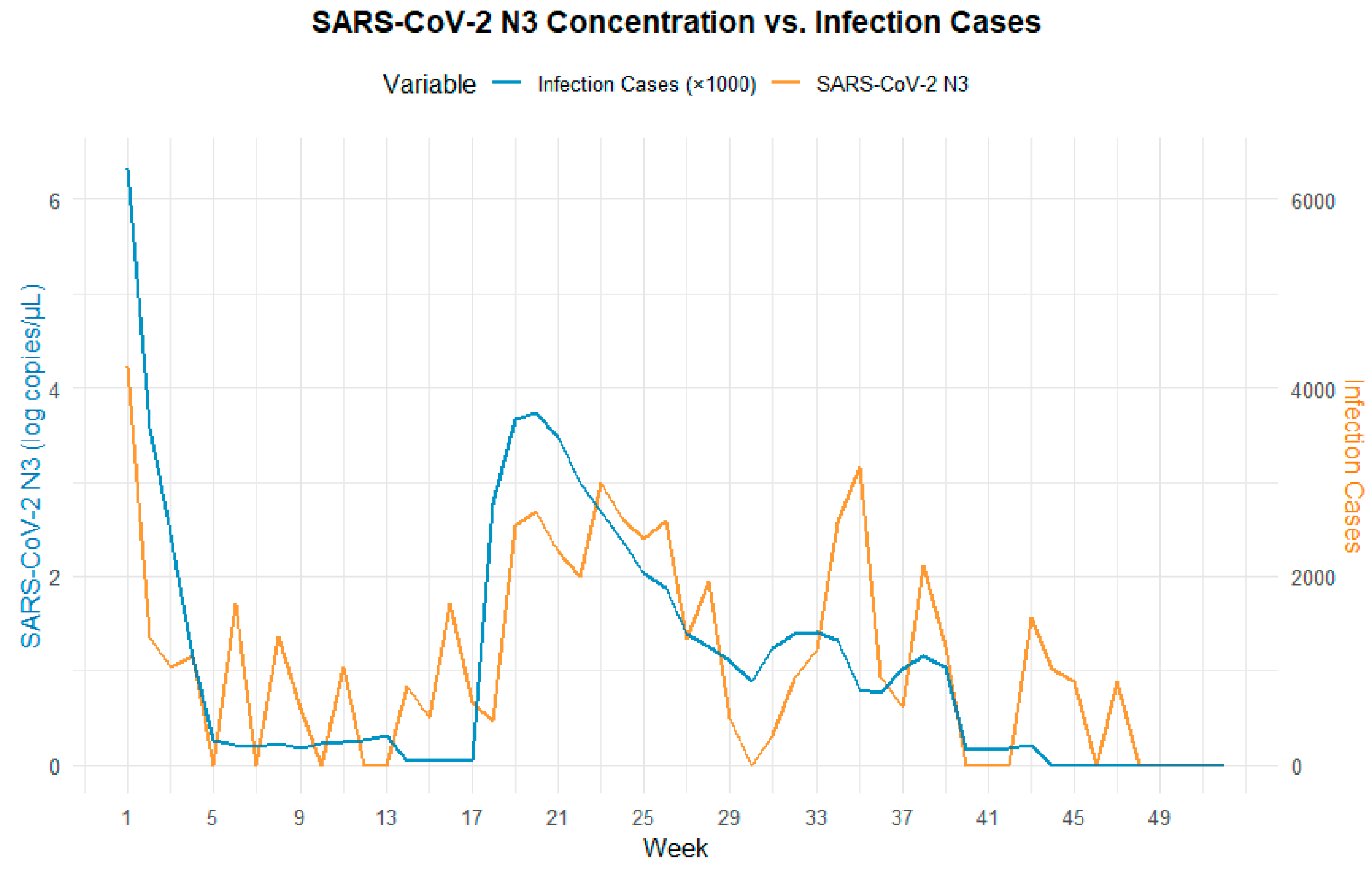


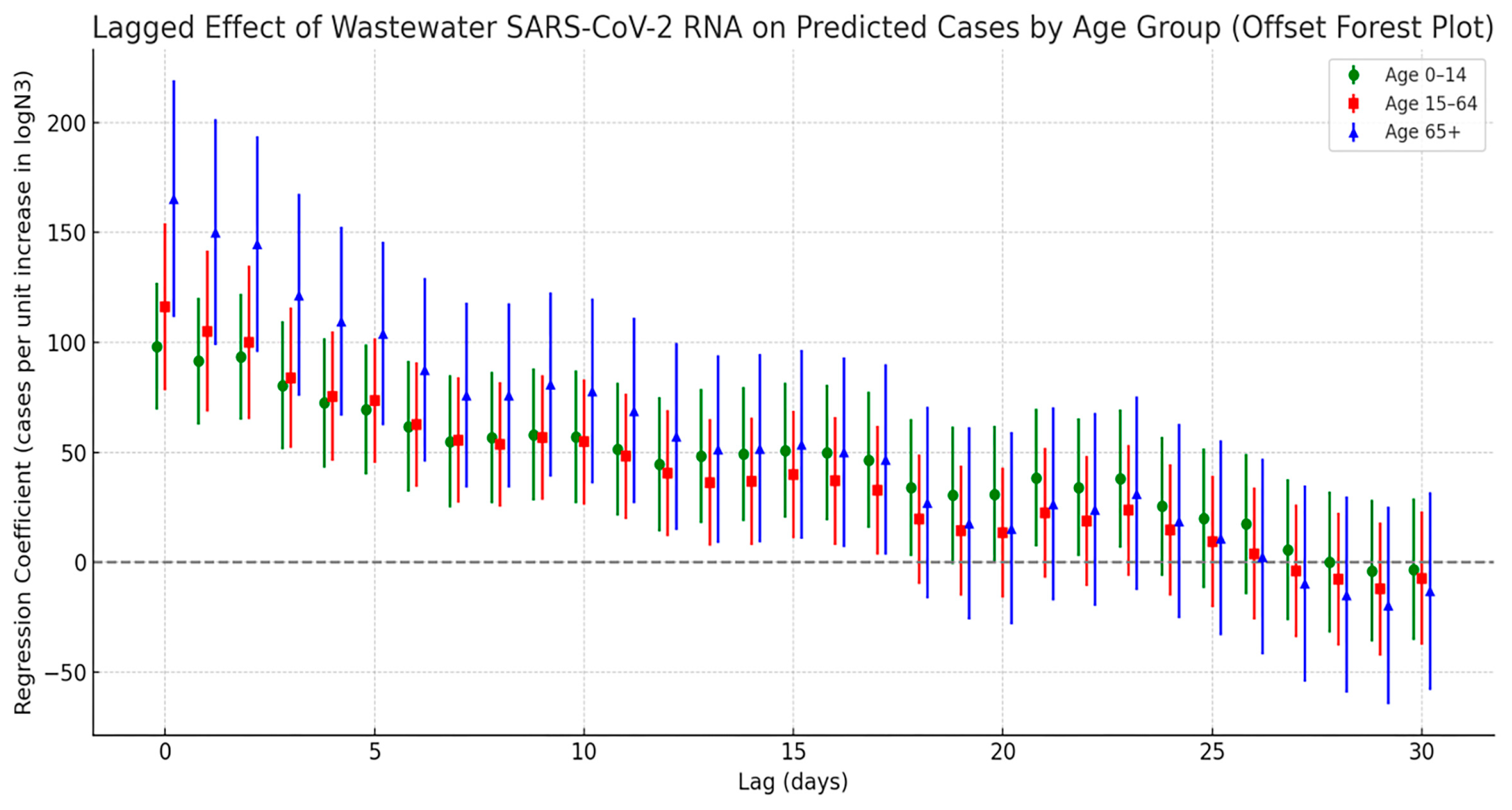
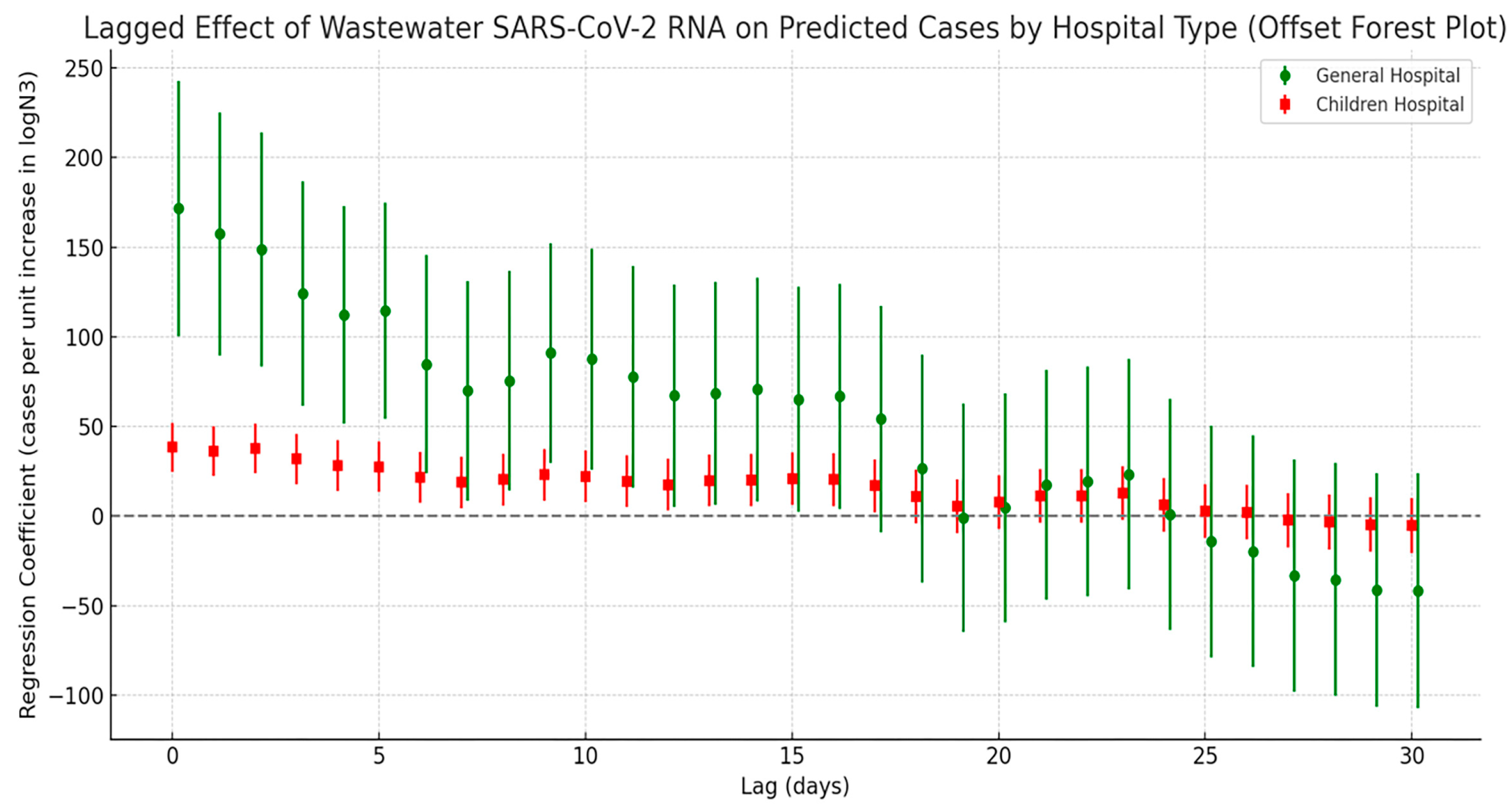
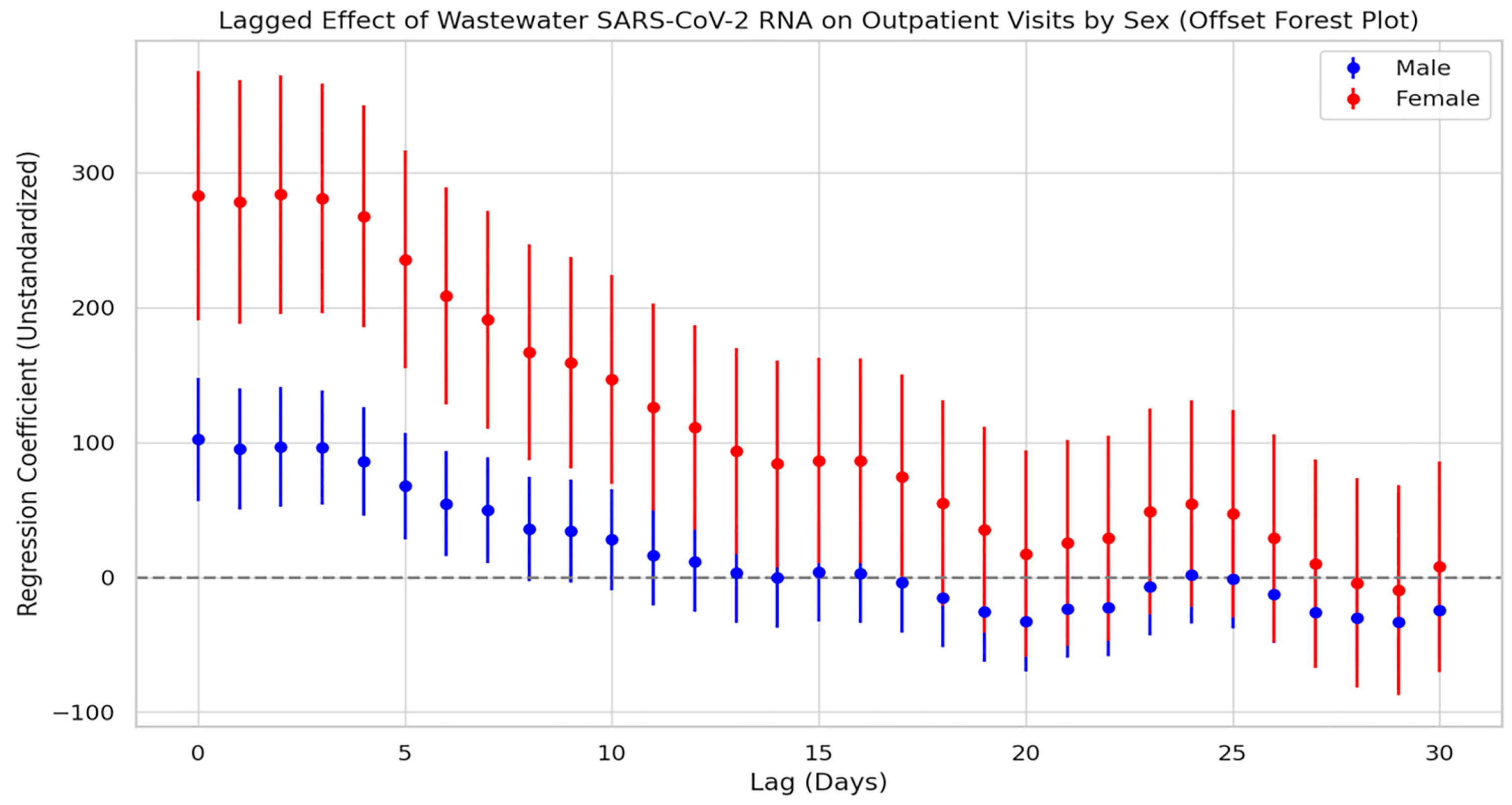
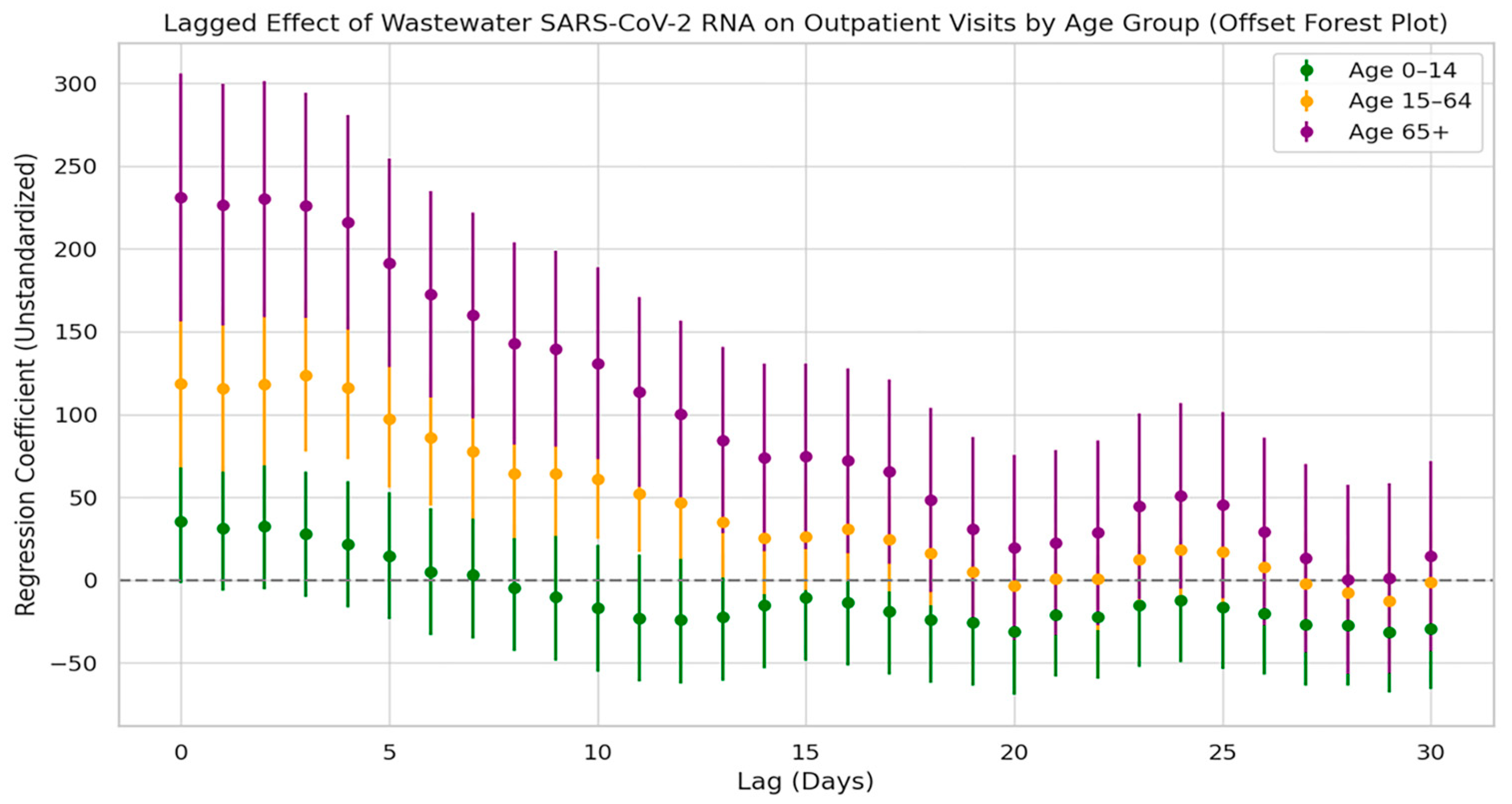
| Month | Number of Tests (N1/N2) | Positive Rate (%) | |||
|---|---|---|---|---|---|
| N1 | N2 | N1∪N2 | N1∩N2 | ||
| January | 12 | 75.00 | 83.33 | 100.00 | 58.33 |
| February | 10 | 70.00 | 50.00 | 80.00 | 40.00 |
| March | 11 | 18.18 | 63.64 | 63.64 | 18.18 |
| April | 12 | 83.33 | 75.00 | 83.33 | 75.00 |
| May | 11 | 100.00 | 90.91 | 100.00 | 90.91 |
| June | 8 | 100.00 | 100.00 | 100.00 | 100.00 |
| July | 11 | 90.91 | 63.64 | 100.00 | 54.55 |
| August | 12 | 75.00 | 58.33 | 83.33 | 50.00 |
| September | 10 | 90.00 | 90.00 | 100.00 | 80.00 |
| October | 11 | 45.45 | 63.64 | 72.73 | 36.36 |
| November | 11 | 63.64 | 54.55 | 81.82 | 36.36 |
| December | 13 | 38.46 | 30.77 | 53.85 | 15.38 |
| Total | 132 | 69.70 | 67.42 | 84.09 | 53.03 |
| Month | Ct Value | Viral Load (Gene Copies/µL) | Log10 Viral Load (log10 Gene Copies/µL) | |||||
|---|---|---|---|---|---|---|---|---|
| N1 | N2 | N1 | N2 | N3 | N4 | N3 | N4 | |
| January | 30.44 | 28.44 | 527.96 | 71.80 | 18.59 | 5910.49 | 1.27 | 3.68 |
| February | 31.19 | 33.66 | 269.35 | 8.15 | 1.00 | 269.35 | 0.00 | 2.27 |
| March | 34.53 | 35.20 | 1.00 | 8.85 | 1.00 | 8.85 | 0.00 | 0.95 |
| April | 34.53 | 35.90 | 81.84 | 5.71 | 5.71 | 86.87 | 0.76 | 1.94 |
| May | 31.13 | 31.21 | 1395.98 | 141.60 | 141.60 | 3503.28 | 2.15 | 3.54 |
| June | 30.10 | 32.80 | 3124.90 | 79.26 | 79.26 | 3124.90 | 1.90 | 3.49 |
| July | 30.25 | 27.30 | 482.64 | 10.12 | 8.98 | 15,405.71 | 0.95 | 4.19 |
| August | 31.33 | 28.70 | 503.10 | 7.07 | 2.65 | 1191.34 | 0.42 | 3.08 |
| September | 32.39 | 34.59 | 428.64 | 13.81 | 13.81 | 1200.21 | 1.14 | 3.00 |
| October | 25.42 | 26.41 | 1.00 | 65.74 | 1.00 | 5476.77 | 0.00 | 3.74 |
| November | 28.64 | 35.05 | 436.34 | 3.96 | 1.00 | 436.34 | 0.00 | 2.64 |
| December | 35.56 | 36.88 | 1.00 | 1.00 | 1.00 | 4.99 | 0.00 | 0.65 |
| Month | Number of Tests | Number of Positives | Positive Rate (%) |
|---|---|---|---|
| January | 167 | 60 | 35.93 |
| February | 177 | 16 | 9.04 |
| March | 241 | 14 | 5.81 |
| April | 206 | 2 | 0.97 |
| May | 208 | 90 | 43.27 |
| June | 234 | 65 | 27.78 |
| July | 193 | 40 | 20.73 |
| August | 210 | 55 | 26.19 |
| September | 218 | 55 | 25.23 |
| October | 219 | 9 | 4.11 |
| November | 212 | 0 | 0.00 |
| December | 187 | 0 | 0.00 |
Disclaimer/Publisher’s Note: The statements, opinions and data contained in all publications are solely those of the individual author(s) and contributor(s) and not of MDPI and/or the editor(s). MDPI and/or the editor(s) disclaim responsibility for any injury to people or property resulting from any ideas, methods, instructions or products referred to in the content. |
© 2025 by the authors. Licensee MDPI, Basel, Switzerland. This article is an open access article distributed under the terms and conditions of the Creative Commons Attribution (CC BY) license (https://creativecommons.org/licenses/by/4.0/).
Share and Cite
Wang, W.; Li, R.; Chen, S.; Chen, L.; Jiang, Y.; Xiang, J.; Wu, J.; Li, J.; Chen, Z.; Wu, C. Wastewater-Based Surveillance of SARS-CoV-2 and Modeling of COVID-19 Infection Trends. Trop. Med. Infect. Dis. 2025, 10, 264. https://doi.org/10.3390/tropicalmed10090264
Wang W, Li R, Chen S, Chen L, Jiang Y, Xiang J, Wu J, Li J, Chen Z, Wu C. Wastewater-Based Surveillance of SARS-CoV-2 and Modeling of COVID-19 Infection Trends. Tropical Medicine and Infectious Disease. 2025; 10(9):264. https://doi.org/10.3390/tropicalmed10090264
Chicago/Turabian StyleWang, Wenli, Ruoyu Li, Shilin Chen, Liangping Chen, Yu Jiang, Jianjun Xiang, Jing Wu, Jing Li, Zhiwei Chen, and Chuancheng Wu. 2025. "Wastewater-Based Surveillance of SARS-CoV-2 and Modeling of COVID-19 Infection Trends" Tropical Medicine and Infectious Disease 10, no. 9: 264. https://doi.org/10.3390/tropicalmed10090264
APA StyleWang, W., Li, R., Chen, S., Chen, L., Jiang, Y., Xiang, J., Wu, J., Li, J., Chen, Z., & Wu, C. (2025). Wastewater-Based Surveillance of SARS-CoV-2 and Modeling of COVID-19 Infection Trends. Tropical Medicine and Infectious Disease, 10(9), 264. https://doi.org/10.3390/tropicalmed10090264








